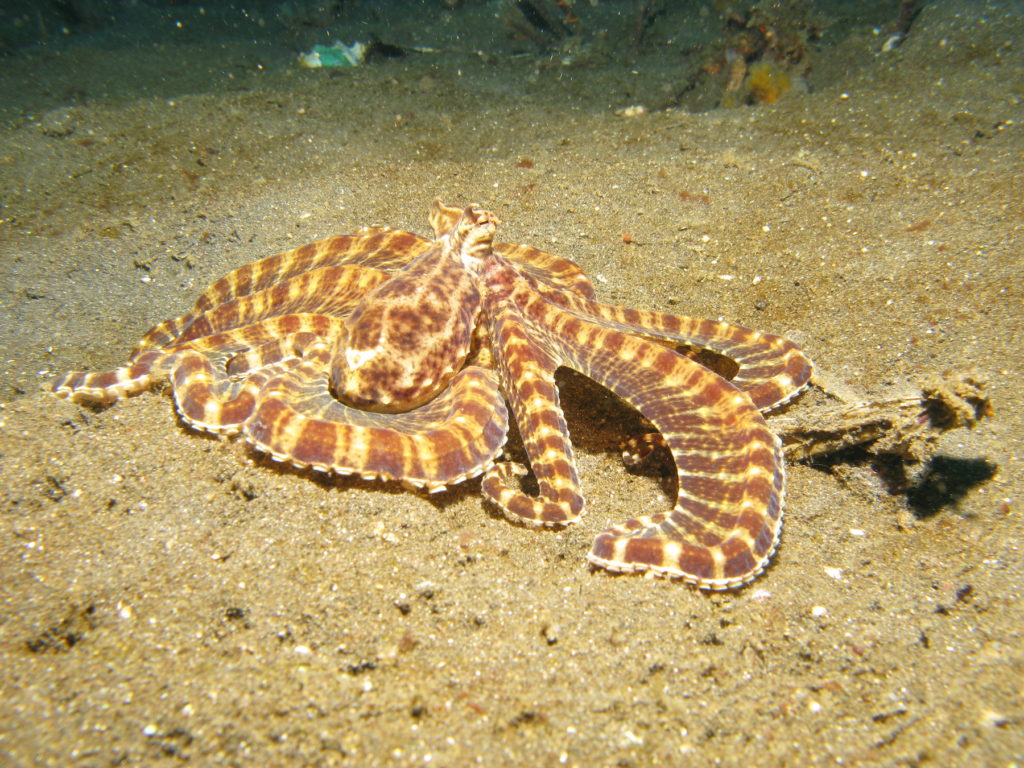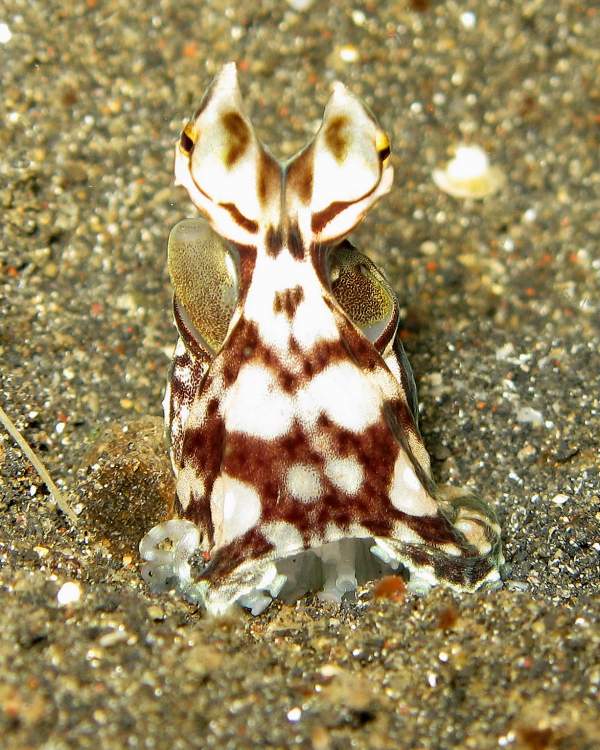Scientists diving in a river mouth off northern Sulawesi in 1998 were astonished to discover this spectacular new species: an eight-legged impersonator that takes the art of disguise to levels previously unknown in the animal kingdom.
The great pretender
We already knew that octopuses are impressive and intelligent molluscs. They change the colour and texture of their skin at will in order to blend into the rocks, weed or corals of their undersea background, and can squeeze their flexible, muscular bodies into all manner of improbable hiding places. We also knew, of course, that evolution has equipped some animals to imitate others in order to gain an advantage in the struggle for survival.

What scientists had never previously observed, however, was an animal with the capacity to impersonate a whole range of others. This small, 60cm octopus is just such an animal. Careful observation over two years revealed that it was able to mimic at least 15 of its neighbours, ranging from lion fish and flat fish, to sea snakes, anemonies, stingrays, mantis shrimps, jellyfish, giant crabs and brittle stars. Small wonder, then, that it remained undetected for so long.
Eight-legged oscars
The mimic octopus lives in tunnels and burrows on the estuarine seabed. Often it lurks beneath the mud with just its eyes protruding. But when it ventures out into exposed water – either in search of prey or simply to get from A to B – it must run the gauntlet of predators such as sharks and barracuda. And this is when the show begins.
When confronted with a threat, the octopus contorts its body ingeniously and controls its movements in order to impersonate each model. For a flounder or sole, for example, it draws up all eight legs into a flattened leaf shape and – powered by jet propulsion from its funnel – undulates across the seabed in the manner of a flatfish.
For a lionfish, it hovers just above the sand with its arms trailing below the body in the form of a lionfish’s poisonous fins. For a jellyfish, it swims to the surface, then spreads out its arms around its body and sinks slowly downwards. And for a sea anemone, it stations itself on the seabed and waves its arms upwards, each crimped into the telltale zigzags of stinging tentacles.
Colour also plays a part. When impersonating a venomous banded sea snake, for instance, the octopus’s usual mottled brown and white transforms into the bold black and yellow bands of the reptile. It then buries six of its legs in the sand and waves the remaining two in opposite directions in an uncanny imitation of two venomous serpents.
As though this remarkable repertoire wasn’t enough, the mimic octopus can shift from one impersonation to another as it crosses the seabed, and will tailor its disguise to each threat. It produces the sea snake act, for instance, when attacked by territorial damselfish, which fear the reptile as one of their chief predators.
Armed for life
The mimic octopus feeds on small crustaceans, worms and fish, using its long arms to probe deep into burrows and flush out small prey, and its tough beak to kill and crunch up its catch. Its disguises do a job here too: it will, for instance, wave an arm to mimic the courtship display of a crab then grab and devour the unsuspecting would-be suitor when it comes within range.
Like all octopuses, a male mimic octopus deposits his packets of sperm directly into the female’s mantle cavity using a specialised arm called a hectocylus. Shortly afterwards, this falls off and in the months following he dies. After fertilisation, the female lays her eggs, which she arranges into strings and carries in her arms.
The female dies around the time that the larvae hatch. They then join the ocean’s plankton cloud and, when mature, return to take up their place on the seabed.
At a glance
Length: up to 6ocm
Food: small crustaceans and fish
Reproduction: female carries eggs in strings
Habitat: nutrient-rich river estuaries
Distribution: Sulawesi and Bali (Indonesia); discovered in the Lenbeh Strait, northern Sulawesi
Status: Data Deficient
